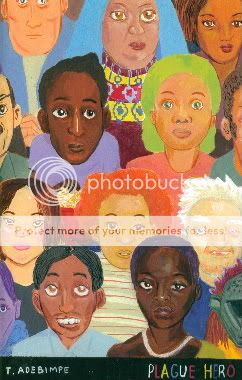Posts Tagged ‘comics reviews’
Comics Time: Giraffes in My Hair: A Rock ‘n’ Roll Life
January 6, 2010
Giraffes in My Hair: A Rock ‘n’ Roll Life
Bruce Paley, writer
Carol Swain, artist
Fantagraphics, 2009
136 pages, hardcover
$19.99
Pencil is not an easy medium to publish in for a cartoonist–just ask the superhero artists whose work looks like the proverbial cake left out in the rain when “digitally inked” or colored right off the original pencils. But Carol Swain makes it look easy, and I think it’s because she’s figured out a way to spot blacks with a pencil. Those sooty shadows and clouds and night skies and manes of wild hair suffuse her work in Giraffes in My Hair with a sort of negative-image glow, popping her foregrounded figures off the page with a barely-there white aura. Couple it with her ever-shifting angles and it’s a damned effective way to create a sense of space and depth, reminiscent of similarly adroit strategies by Jeffrey Brown and Ben Katchor. If Swain’s jarring close-ups make her panels less immersive than theirs, her porous gray shadings make up for it with atmosphere–an inviting softness, tinged with just enough smokiness to remind us that what’s going on here isn’t entirely pleasant. The overall effect works so well that I really had to stop myself and peer at her pages to figure out what made them tick. I was too busy being propelled along by the effortlessness of the art.
So Giraffes, a collection of anecdotes from Bruce Paley’s teens and twenties on America’s countercultural fringe, is a breezy read. But it’s one rooted in an almost unchanging nine-panel grid with sparse, nearly monotone narration. At times this allows the comics to tip over into bluntness, particularly with the ending to some of the stories: The tale of how Paley avoided Vietnam ends with a shot of the Wall; a story of New York City’s ’70s heroin scene ends with Death itself offering us a bag of smack. But in general, the art and the writing are a perfect fit. Swain’s art rarely calls attention to or gets in the way of itself, and in that it meshes seamlessly with Paley’s deadpan “here’s what happened” narrative style, his reluctance to overstate or oversell the import of the anecdote reminiscent of Harvey Pekar’s. (Of course, Pekar’s work rises and falls on the strength of his collaborators–Paley’s got Swain, so there’s not much falling to do here.)
Yet at the same time the presence of that subtitle indicates a unifying theme, which makes Paley’s storytelling choices all the more interesting. The first story shows an 18-year-old Paley ditching college and leaving home to hitchhike cross-country with his girlfriend, but the home life that led him to drop everything and drop out is relegated to a quick line of dialogue and about half a page upon his return from the journey. As hippies give way to punks we suddenly discover that Paley’s a habitual heroin user, but we never see his introduction to the drug. A story about an ill-fated attempt to import drugs from overseas sees Paley casually mention time spent in Tangiers, but up until that point his adventures had been strictly domestic. In some graphic memoirs these lacunae would be maddening; here’s they’re sort of the point.
Paley’s not claiming anything spectacular about the life he lived or the stories he plucked from it. The way he tells it and Swain draws it, living on the edge feels like an interchangeable commodity with Pekar’s life as a civil servant. An interesting conversation with the janitor may be replaced by doing speedballs with Johnny Thunders, but the game’s the same: get by, find a little happiness when you can, and cling to the stories that comprise your life, the recounting of which has a value all its own.
Comics Time: Big Questions #13: A House That Floats
January 4, 2010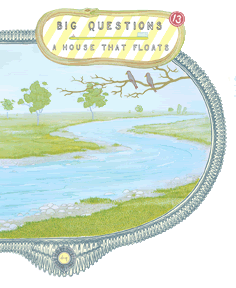
Big Questions #13: A House That Floats
Anders Nilsen, writer/artist
Drawn & Quarterly, 2009
44 pages
$9.95
My sincere hope is that a couple years from now the collected Big Questions will lodge itself at the top of future Best of the Decade lists on the strength of material largely published the previous decade, like Jimmy Corrigan and Black Hole before it. Certainly Nilsen is a capital-M Major Talent, a real world-beater for his generation, but the book by which he will be defined has not yet been released. The two Monologues for… books from Fantagraphics delight me with their weird existentialist stick-figure stand-up comedy, but talk about an aquired taste. Dogs and Water might pick up steam in the post-The Road world, but it’s always gonna read grim, and its strange release pattern–first as the fattest stapled pamphlet you ever saw, then a slightly revamped version in hardcover–threw folks for a loop. Don’t Go Where I Can’t Follow devastates virtually anyone who reads it, but its hodgepodge hybrid format, arising from its tragic origin as a travelogue-turned-eulogy, makes it a tough item to classify. The End could end up topping my personal Best of the Decade list, but it’s a one-shot Ignatz-format pamphlet. I could see his mythological comics for Kramers Ergot clicking but there’s just not enough of them.
But soon, along will come a thick hardcover of this monumental series, tracing its evolution from xeroxed minicomics sold at a table alongside Jeffrey Brown, John Hankiewicz, and Paul Hornschemeier comics, through its adoption by D&Q, into its status as one of the only regularly released alternative serials in North America. It’s as fragile and frightening as any of Nilsen’s many, many comics about the baffling horror of senseless death, but it’s also a funny-animal book stuffed with subplots and side-stories and borderline gag strips about wisecracking birds. It works as a showcase of pure cartooning as well as even Nilsen’s most abstract, “pure comics” stuff from MOME or The End, but in the service of a sad and searing realism whose beauty is apparent to any reader even remotely open to altcomics work–certainly I’d stack this issue’s cockpit sequence against anything else this year for sheer stunning loveliness. It functions as allegory, but then turns around and acknowledges its own allegorical nature, and ads enough detail and twists to hold up as a real-deal semi-adventure. It manages to capture and cry for the world’s cruelty, yet hold alive the hope offered by cooperation and community and small kindnesses, even those arising from bare enlightened self-interest, as well as anything this side of Deadwood. I laughed, I cried, in the space of this issue alone. Big Questions is a great comic.
Comics Time: Pluto: Urasawa x Tezuka Vols. 1-3
January 1, 2010
Pluto: Urasawa x Tezuka Vols. 1-3
Naoki Urasawa, writer/artist
Takashi Nagasaki, writer
Based on Astro Boy: The Greatest Robot on Earth by Osamu Tezuka
Viz, 2009
200 pages each
$12.99 each
I take back everything I said about Naoki Urasawa. Well, okay, no I don’t, but everything I said about Naoki Urasawa definitely does not apply here. Finally, one of his series contains visual elements that exist for more than simply conveying the information of the story as clearly and dramatically as possible. And I didn’t think that was in the offing, by the way, since in the first few pages you get a “guy with a gun turns a corner, does a half-turn and whips the gun at the camera” sequence that struck me as an unimaginative, un-comicsy rip from the cinema. But a few pages later our straight-laced, sad robot detective Gesicht informs a robot-maid wife that her robot-cop husband has been killed in the line of duty, and Urasawa gives us a series of close-ups of the grief-stricken robot’s machine face, which, of course, never changes. And blam, I was hooked.
In Pluto, a contemporary-superhero-comics-style “reimagining” of a classic < i>Astro Boy story by Osamu Tezuka, Urasawa uses the presence of robots as embodiments of surrealism. From the bereaved wife’s static expression, to the towering North No. 2 in his judge’s robe, to sinister Brau 1589’s mangled scrap heap of a body, to a revamp of Astro Boy (aka Atom) that makes him less like a jaunty short-pantsed slugger and more like an eerie kid out of The Shining, they’re the flourish of Weird, the touches of visual poetry, that I always wanted from my limited experience with Urasawa’s work. That his line and design sensibility is otherwise such a just-the-facts affair only heightens their “thing that should not be” effect.
And they seem to have unleashed more where that came from. The series of murders that are the series’ central mystery are themselves like staged art installations, sort of like the theory that holds the Black Dahlia’s murder as a macabre Surrealist masterpiece. Elsewhere, jagged black lines emerge from transmission static as a literal representation of despair; a huge black thing slouches half-unseen through the smoke and sand of a war-ravaged Persian town, the sight of it driving a young boy mad; traumatic memories of war are represented by indistinct flurries of the violent clash of robotic limbs, or a decontextualized and repeated offer of money for bodies; a sentient teddy bear sits immobile, a puppet master at the mercy of whoever moves it around; a tiny figure is captured leaping from rooftop to rooftop in the final images recorded by a dying robot, its blurry body silhouetted against the sky.
You add all this to Urasawa’s usual page-turning panache, and suddenly what had felt like mere proficiency gains the power to haunt and to move. There are the usual resonances with and/or swipes from other genre-art touchstones: Brau 1589 is Hannibal Lecter with microprocessors, there’s an Iraq War riff as is custom with science fiction that wants to be taken seriously this decade, and the plot–super detective believes that other super beings of his acquaintance are being hunted by a serial killer so he travels around to warn them with varying degrees of success–is straight-up Watchmen Chapter One. Plus, the whole thing is an adaptation of a story about Japan’s Mickey Mouse/Superman cultural juggernaut. (“Flying boy robot in shorts” is the extent of my knowledge of Astro Boy, so what Urasawa is taking from Tezuka narratively or visually is beyond me.) But instead of coming across like button-pushing, all of this, and all the chases and clue-hunting and races against time and unsuspected reversals that are Urasawa’s thriller trademarks, now feels like ammo in the arsenal of someone taking aim at some big old-fashioned sci-fi questions about war, technology, human rights, friendship, childhood, and that old chestnut, what it means to be human. The thing that fills me with delight here is that when you look at that robot maid just standing and staring, unable to express her emotion, you get the sense that for once, this master penciller and plotter doesn’t have all the answers.
Comics Time: You’ll Never Know Book One: A Good and Decent Man
December 30, 2009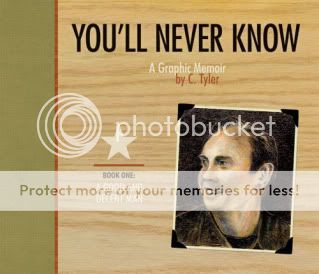
You’ll Never Know Book One: A Good and Decent Man
C. Tyler, writer/artist
Fantagraphics, 2009
104 pages, hardcover
$29.95
You’ll Never Know is a memoir about creating a memoir. In it, the affable but scatterbrained Carol Tyler, buffeted by her separation from her cheating, indecisive husband and by her own memories, finds solace in attempting to construct for her father a scrapbook chronicling his military service during World War II. As becomes clear during a climactic dream sequence in which Hitler proclaims that the trauma inflicted on her father during the War warms his heart from beyond the grave, doing this is much more to Tyler than an attempt to set the historical record straight or satisfy her own curiosity (though it is both of those things as well). It’s the product of a realization that something vital was taken from her father, whom she sees as hard-working, lovably ornery, and an incorrigible cut-up, yet also distant and damaged in a way that suggests a missing puzzle piece she might be able to reconstruct.
Therein lies the problem. So personal is the project to Tyler that in some basic ways it fails to translate to the reader. Her dad, Chuck, is a gruff dude to be sure, but funny and lively. He’s apparently a brilliant handyman, a helluva dancer, he swept the hottest girl in the base’s secretarial pool off her feat, he tears it up at the Pop Hop to which he escorts Carol as a teen, he’s undyingly romantic toward her mother, and most importantly he eventually unloads his previously unspoken military memories for her not once but several times–and yet Tyler insists upon the notion that the horror of his experiences in Italy broke him. It’s just not present in the text. In recounting the plot just now I realized how very similar it is to Art Spiegelman’s experience with his own father in Maus, which is a solid point of comparison–compared to the nightmarish psychological scarring the Holocaust inflicted upon Spiegelman’s parents, and how painfully Spiegelman evokes it, what Tyler’s up to in her depiction of her father remains obtuse.
Tyler’s confidence in the face of this lacuna is reflected in her buoyant but ramshackle art. Her comics’ landscape layout and dashed-off line and lettering (complete with blue-pencil guidelines) evoke a mid-tier slice-of-life webcomic; they’re pleasant and likeable, but they make this very serious and personal project feel slightly airy and inconsequential. They’re not helped in this regard by their presentation as a supplement to the actual scrapbook she’s putting together for her father, nor by her presentation of herself in an always slightly humorous fashion even when literally prostrated by her husband’s infidelity and departure. Transitions and juxtapositions, too, feel under-considered, from the cuts to and from her own life story to this volume’s abrupt cut-off point. I’m not saying her familial war story needs to be the unrelenting legacy of horror that was Maus–their experience was and is different and so should be Tyler’s book about it. But the effect of her writing and drawing serves to cut the tale’s gravitas off at the knees. I know it’s a story she needed to tell; I’m not convinced it’s a story that needed to be told, or perhaps more to the point, that I needed to hear.
Comics Time: The Photographer
December 28, 2009
The Photographer
Didier Lefevre, story/photographs
Emmanuel Guibert, writer/artist
Frederic Lemercier, colors/layouts
First Second, 2009
288 pages
$29.95
The high point of The Photographer is literally the geographical high point of The Photographer. After chronicling a Doctors Without Borders mission into the war-torn country–then occupied by the Soviet Union–lensman Didier Lefevre makes the ill-advised decision to leave his more experienced Western colleagues and return through the mountains to Pakistan alone. Abandoned by guides who barely knew the way themselves, Lefevre finds himself stranded at the summit of a mountain pass. In the gloom he desperately tries to make it through by nightfall, and is reduced to beating his exhausted, dying horse until he realizes neither of them can go any further. He bivouacs beneath his horse’s body, melting snow in his mouth in an attempt to stay hydrated, cursing his recklessness and the fecklessness of his escorts. Realizing that he will most likely never make it down the other side of the mountain, he writes a note to his girlfriend and then takes the most beautiful, dramatic, and chilling photographs of his journey, capturing his emaciated horse and the nightmarish wasteland that surrounds them, believing in his heart that they are the last things he will see. In the several pages that chronicle this most dire stretch of Lefevre’s memoir, artist Emmanuel Guibert manages to capture the photographer’s initial panic at being left alone in an unfamiliar place, contrasting his nervous movements and increasingly desperate drive to move on against the cold and motionless stones of the land and small dwelling where he was abandoned. And as Lefevre and his horse reach what he believes to be their final resting place, they are depicted solely in silhouette, black against the icy twilight blues provided by colorist Frederic Lemercier. The effect is a perfect evocation of Lefevre’s Sisyphean plight–frantic effort colliding with unyielding futility and ultimately despair. Gorgeous, frightening, powerful comics.
Alas, it’s one of the only sequences in the whole of The Photographer‘s 288 pages to which any of those four words apply. The story of Lefevre’s trip into and out of Afghanistan is plodding journey through a featureless wash of minutiae about his companions, their hosts, their jobs, and the land. Obviously, the choice to leech the proceedings of nearly any drama–save for Lefevre’s near-death at the mountaintop and a trio of gut-punch accounts of war-wounded children, nothing cuts through the haze of tedious detail–was a conscious one, meant to evoke the reality of life in a desperately poor and brutalized country, and how no grand Orientalist gestures are possible, only the quotidian work of traveling there, setting up shop, and treating those who can be treated. However, a flawless evocation of boredom is still boring.
Meanwhile, memoirists of conflict like Joe Sacco and Art Spiegelman have shown that dull horror can make for compelling comics. But Guibert’s work here is tough to classify as comics at all. Yes, there are panels, word balloons, caption boxes, but his visual contribution is essentially an unending series of stiff minimalist portraits that look like they were produced with a photoshop filter, or one of those dreadful animation projects that take live action footage and boil them down to a “cartooned” style. They demonstrate the story rather than tell it. Even on top of Guibert and layout artist Frederic’s lack of attention to image-to-image flow or to the composition of a page, big blocks of narrative text and the interspersal of Lefevre’s actual photographs all but prevent the effects of accumulative or juxtaposed meaning that are so crucial to the book’s nominal medium of comics. Backgrounds are frequently dropped altogether, replaced with a baffling, uncommunicative palette of pea green and acidic yellow; one rare sequence where backgrounds were present stands out for its wrongheadedness, with rocky terrain all but obliterating the conversation in which Lefevre argues the head of his expedition into letting him return by himself. That Guibert had it in him to produce that knockout climax makes the lack of energy and life in the rest of the book all the more depressing. Nobly intentioned though it may be, bad comics is bad comics.
Comics Time: Naoki Urasawa’s 20th Century Boys Vols. 4 & 5
December 25, 2009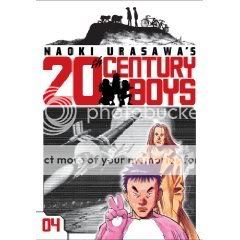
Naoki Urasawa’s 20th Century Boys Vols. 4 & 5
Naoki Urasawa, writer/artist
Viz, 2009
200 pages, Vol. 4
216 pages, Vol. 5
$12.99 each
There are two major developments in these installments of Urasawa’s cult-conspiracy thriller. The first is the introduction as a secondary protagonist of Wolverine. The gruff longhaired badass who plays by his own rules but has a heart of gold and so on–named Shogun, in case you didn’t pick up on his awesomeness–was technically introduced in Vol. 3, but here we find out who he really is, get an origin story involving a wise old sensei, and connect him to the main thread of action. The second major development, which is interesting because it upends the first, is a big honking shift of the whole territory of the story that came waaaaaay quicker than expected. I won’t spoil it beyond the spoilage that is announcing its existence, but it’s what longtime watchers of Lost might call a “game-changer.” And if you opt to look at Shogun as the Sawyer figure instead of the Wolverine figure, that may be even more helpful in terms of establishing just how expertly Urasawa plays with genre tropes, insofar as these same tropes would later be key to the greatest work of American pop/pulp fiction this decade. 20th Century Boys has a lot in common with Lost, a neutral observation that doubles as an endorsement.
PS for readers of the series: The first lyrics in T. Rex’s “20th Century Boys” are “Friends say it’s fine, friends say it’s good.” Ha!
Comics Time: Naoki Urasawa’s 20th Century Boys Vols. 1-3
December 23, 2009
Naoki Urasawa’s 20th Century Boys Vols. 1-3
Naoki Urasawa, writer/artist
Viz, 2009
216 pages, Vols. 1&2
200 pages, Vol. 3
$12.99 each
I don’t like to read manga series until I have the whole thing. It’s not like superhero serials that are ongoing in perpetuity, or TV shows where the same thing is theoretically the case–these stories are serialized but they’re of a finite length, and I find that if I try to read a little here, a little there, I end up forgetting half of what’s going on by the time I catch up with later volumes. This isn’t really the fault of the material, mind you, it’s just because I’m not terribly bright.
Anyway, sometimes needs must, and so I found myself reading the three volumes of 20th Century Boys I have in my possession at the moment. (Without having Vols. 4-6, or god help me, without having finished Monster, since I’m missing about six volumes in the middle of the run and totally can’t remember what happened in the three or four volumes I already read. Like I said, not the sharpest knife in the drawer.) And this probably comes as a surprise to no one, but they’re a lot of fun. The story’s like a cross between Stephen King’s It and the Aum Shinrikyo Tokyo subway attack, with thirtysomething go-nowhere convenience-store franchisee Kenji discovering that the heroes-and-villains game he helped concoct as a kid is being used as a how-to manual for murdering people by a shadowy cult, most likely led by one of his childhood friends. The drill so far is one of watching bodies pile up and the revelations slowly accumulate, often in sublimely unexpected ways. There’s at least one supporting character who gets offed way before I’d have seen it coming, a lot of the secrets are way more out in the open than I’d have expected them to be at this stage in the game (a lot of “so, now you know that I know what you know”), there’s a wooly subplot involving a psychic bum, there’s a very cool t-shirt-ready symbol for the death cult…a thrill a minute, baby, and dammit, I wish I had the other three volumes.
That said, I think what prevents the Urasawa I’ve read from springboarding off its obvious proficiency with genre into the realm of genuinely great art is that his actual art, his drawings, are strictly functional. Actually, that’s not quite the word for it. “Strictly functional” implies “merely adequate,” and it’s more than that. The visual storytelling is crystal-clear, which is a huge help for a mystery translated from a foreign language with its own cultural cues. The character designs are easy to keep track of even as childhood friends are reintroduced at a dizzying pace. The line is as slick as manga gets, retaining energy during quieter scenes like a coiled spring that boings back up during confrontations and action sequences. But it only has style in the sense that, say, your basic Hollywood thriller has: The goal of the art is to stay out of the way of the story. I’m reminded of Pia Guerra’s work on Y: The Last Man–Urasawa would never draw anything that stiff, of course, but that kind of nondescript conveyor-of-information-type art is the sort of thing that works really well for a comic with this kind of broad civilian appeal. Are you here for an art class, or are you here to find out if Kenji can save the world?
Comics Time: You Are There
December 21, 2009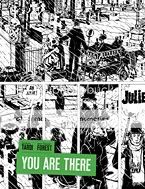
You Are There
Jean-Claude Forest, writer
Jacques Tardi, artist
Fantagraphics, 2009
196 pages, hardcover
$26.99
Wow, what a turnaround I made on this book in the space of a few pages. One of the perils of being so hung up about spoilers that you go into a book without even knowing what it’s about is that oftentimes it turns out you’ve got an idea in your head of what it’s about anyway, and that idea can be wrong. My only experience with Tardi was his adaptation of Jean-Patrick Manchette’s daylight-noir West Coast Blues, so when I saw a guy in a bowler hat standing there in a graveyard on the cover I figured “okay, a period-piece crime novel, like The Black Diamond Detective Agency or something.” Instead, right from the first page, you just get smacked with this torrent of verbiage from this daffy annoying tall skinny guy as he runs around atop the walls of some crazy little village opening gates for people. What the fuck is this?
It’s an absurdist satire, is what it is, and a pretty terrific one. And good God is it French. Once I realized what was up, my dim memories of Jarry and Ionesco and Beckett flickered one by one back to life. Delusions of grandeur, farcical authority figures, goofily symbolic names, talk talk talk that says nothing, all atop a fundamentally ridiculous premise.
Arthur There, the heir of a long-defunct line of aristocrats, has lost his ancestral estate but gained the legal right to erect walls between the properties of all the people who now live on it and control their comings and goings. Only by “control” I mean “run when they ring a bell for him to open the gate.” A Strangelovian element is injected when the president of France, on the verge of losing his bid for reelection, settles upon the unique legal status of There’s labyrinthine fiefdom as the perfect pretext for setting up a rival government-in-exile. He’d heard of the place thanks to Julie Maillard, the squint-eyed and slatternly daughter of the neurotic There’s chief rival–she once had a watersport-heavy affair with the President, though now her sights are set, for reasons obscure even to her, on There. And some other dudes too. It’s easy to picture it as one of those long-form fourth-season Monty Python episodes, with Eric Idle as There, Michael Palin as the President, and Carol Cleveland as Julie, if that helps.
So like I said, once I figured out what was up–once I realized that the dialogue was overwhelming and annoying on purpose, once I realized that the characters were deliberately ridiculous and their motivations purposefully flimsy and absurd–I was all the way on board. Kudos for that must go to Jean-Claude Forest’s full-bore commitment to writing like that. After a while it feels like the most natural thing in the world to watch There talk to himself on the verge of hysteria for paragraph after paragraph. But the real magic is in watching what Tardi does with Forest’s set-up. The fool’s kingdom of Mornemont is an unforgettable comic-book locale, and the riot of walls and fences and gates that crisscross it provide a perfect visual hook on which to hang the similarly profligate dialogue and nonsensical story. Tardi’s lanky design for There; his recurring motif of vertical stripes everywhere from the gates There opens to the wallpaper of his comically tiny house; his use of tall rectangular panels and layouts that emphasize the page’s verticality; truly masterful rainstorms and snowstorms–it’s seriously a master class on creating a sense not just of place but of a claustrophobic, chaotic, unsustainable state of mind. It isn’t hard to see this on your bookshelf next to Brian Chippendale, Mat Brinkman, or Hans Rickheit: environment and emotion are one and the same here as there. What’s more, the main effect is so clear that the contrasts are all the stronger: Mornemont’s white walls with the President’s black curtains; There’s googly eyes, stovepipe limbs, and funereal suit with Julie’s bovine expressionlessness, swooping curves, and frequently nude white body; the sealed-off snowglobe isolation of Mornemont throughout the book with the sudden border-smashing invasion by the outside world at the book’s climax. It’s a parade of comics effects astutely selected and deftly executed. Killer stuff, and more fun than you remember it from French class.
Comics Time: Plague Hero
December 18, 2009Plague Hero
Tunde Adebimpe, writer/artist
Suciotone, December 2009
28 pages
$4
I can’t find anyplace to buy it–let me know in the comments if you know of one
I’m not going to lie: I checked out the comic Tunde Adebimpe was selling at a table at BKCGF because of his day job. But come for the “Staring at the Sun,” stay for the, bright, fun, and effective painted fight comic. Printed on thick, glossy paper, Adebimpe’s paints really leap off the page as they illustrate his simple set-up, subtitled “A Few Notes on Being and Not Being Myself”: A pink horse guy and a green bird guy (his name’s Myself) square off from the left- and right-hand side of each spread in a boxing match narrated by a strip of playfully metaphorical first-person text running across the bottom. The anthropomorphic fighters are built like characters from an all-ages boxing video game, and indeed the simple two dimensional plane of the action reinforces that feel: Since all they can do is move forward, move back, and punch each other, it’s easy to feel like you’ve got a ringside seat to an all-action button-masher/slobberknocker. When the combatants land a blow, their wounded opponents explode with color at the point of impact; a similarly visually explosive cut to a pair of audience members (“prospective employers, future ex-wives”) manages to convey the roar of the crowd with similar effectiveness. Adebimpe’s writing bounces along with the hardboiled patter of an old-school sports columnist: “That’s when I decided to step in…and Reagan ’84 the poor jerk”; “It was our pan, and we were flashing.” In the end one of the fighters is declared the “WINNAH!” by knockout, which depending on how much you’re willing to play along with the Myself/Not Myself metaphor could Mean Something. But really it’s an exercise in convey action and movement through color and telling a story with a memorable voice–and a successful exercise at that. I hope to see more.
Comics Time: Feeble Minded Funnies/My Best Pet
December 16, 2009
Feeble Minded Funnies/My Best Pet
Lane Milburn/Noel Friebert, writers/artists
Closed Caption Comics, December 2009
28 pages
$7
Hey, they can’t all be winners. The overall Closed Caption Comics aesthetic, to the extent that one can be pinpointed, has long appealed to me: handmade, rough-hewn, silkscreened, markmaking shit, the ballyhooed stylistic dead-end of Fort Thunder in action, you know the drill. In particular I’ve become a big fan of Lane Milburn’s mix of muscularly drawn monsters and uncomfortable humor, gags that yuk it up until it’s too late and you realize how black things have gotten. That takes a real precise mind and hand to pull off. That’s not what you get in Feeble Minded Funnies, Milburn’s half of this flipbook minicomic, however. Instead he apes the broad humor and colloquial rhythms of the undergrounds: parodic violence, torrents of obscenities, a hapless protagonist called Pukeball making his way through a disapproving world while narration hammers his satirical plight home, all that sort of thing. It actually got to the point (right around the swipe at an outdated grim’n’gritty superhero stereotype) where I wondered if this isn’t actually a parody of underground comix. You’d have to be a lot meaner to make that sort of thing work, though. Actually, has anyone ever done a really nasty parody of the undergrounds? I could use one. Anyway. Milburn draws the bejesus out of it all–someday I want to sit and just watch how he puts the bodies of one of his goons together on the page–but the stories and jokes his awesome drawings inhabit here fall flat.
On the flipside you have Noel Freibert’s My Best Pet, which is the story of a sociopathic child who tortures his pets to death told in a sort of camp faux-EC mode. Longtime readers of this blog can no doubt imagine my reaction. I really hate being so predictable about animal-cruelty gags–apparently this even came up in the humor-comics panel at SPX when I wasn’t even there–but for real: another cat in the fucking microwave? What is it that people get out of drawing cats being blown up in microwaves? Are there people who enjoy…okay, that’s a loaded term. Are there people who get something out of comics in which cats are blown up in microwaves? These are not rhetorical questions at all, by the way. I’m a person with a very high tolerance, a need even, for nihilistic horror, but this I don’t get. Like I’m fond of saying when I come across this sort of material, I’m okay with it when I feel as though the artist is attempting to elucidate something about cruelty. But the whole point of this comic, and it’s actually quite entertaining in this regard, is that it’s just going through the motions. Friebert depicts the asshole kid’s parents’ discussions about his plight without even bothering to put them on panel–it’s just panel after panel of exposition, like they can barely be arsed to show up and play their role in the strip. That’s very funny. And yet we get the cat’s oblivious mewlings as it’s placed in the microwave and its subsequent screams of pain in painstaking detail. I mean, fuck that, right? I’m not the only one?
Comics Time: City-Hunter Magazine #1
December 14, 2009
City-Hunter Magazine #1
C.F., writer/artist
Fantasy Empire Magazine Co., December 2009
20 pages
$3, I believe
I have no way of contextualizing this thing. It’s not Powr Mastrs, it’s not even a smaller and stranger but still-quite-obviously-a-minicomic minicomic like Core of Caligula. It’s billed as a “zine,” and there’s a comics sequence, yeah, but it’s mostly illustrations and sketches and doodles and a couple of goofy prose pages and a blown-up xerox of a piece of an issue of USA Today. As such? I still really enjoyed it. C.F. gains more from inscrutability than just about any other working cartoonist; at its best his stuff already has an air of mystery to it, so when stripped even from the relatively loose standards of his “proper” comics, the way he writes out phrases like “MANSION SOFT DRINK” scribbles them out, writes them over again, and follows them up with a stand-alone image of a person walking past a fancy-looking window toward a soda machine, say, takes on a whole new weight. Who the hell is “LUCIO” and why is his name taking up half a page? What does any of it have to do with those rather sexy bondage pin-ups–one of them in full color? Beats me, and that’s quite fine.
The things I could make sense of tickled me, at any rate. The titular strip, set up with a prose introduction by “editor” “Mike Rennet” (does he exist? does it matter?) about the need he felt to discover the big city when he moved to it, follows around a little dude in a memorably C.F.-ian jumpsuit as he walks around the city and just stand around in various places. It’s kind of Pythonesque in its vibe, though I’m finding it difficult to convey. All I know is that I laughed. Same with the second text piece, an editorial from Rennet about how if you live in the city you have to live it up:
Now if you’re reading this thinking I’m standing still in my own poison, mortified by my past and terrified of my future, you’ve got another thing coming. And that thing is my scared, angry fist, smashing through your apartment wall. Your messy, overpriced, uncool, apartment… wall. You’re going to shrivel up; because you don’t know anything about how to work this city, man.
It ends with an exhortation to check out the author’s Facebook page. I got my $3 worth out of this and that’s all the context I need.
Comics Time: A Drifting Life
December 11, 2009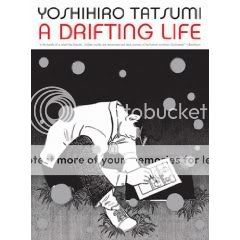
A Drifting Life
Yoshihiro Tatsumi, writer/artist
Drawn & Quarterly, 2009
856 pages
$29.95
I have a friend from college who every time I talk to him we’ll just end up talking about comics and music and movies, and then I’ll hang up and my wife will be like “Did you tell him about our new house?” or “I saw on his girlfriend’s LiveJournal they got a new dog?” and I’ll just have to shrug my shoulders, because there was no way we could fit topics like that into our discussion of Dragon Head or John Romita Jr. or whatever. This massive autobiography is like that: It’s about the joys of pure unabashed obsessive nerdery, the almost physical pleasure of talking and thinking and writing about and working on nothing but the art you enjoy. That makes it an easy book to like. So does Tatsumi’s appealingly simple and direct art, which like a McCloud thesis in action presents Tatsumi and a galaxy of manga-pioneering stars as lovable little caricatures you never get sick of watching and rooting for. And so does the history lesson about the Japanese comics industry that it inevitably teaches. Comics as a mass medium, comics as a legitimate art form, book-format comics, comics in a variety of genres for a variety of age groups and interests–nearly everything the American comics industry is only now achieving, and in some cases may actually never achieve, Japanese comics had already done decades ago. It’s like if we’d fought World War II against Hicksville.
The thing is, much of what makes it such an easy book to like also makes it a hard book to love. Tatsumi’s relentless focus on manga, its omnipresence as the focalizing device for the story, left me scratching my head about whether other aspects of his life really did intrude upon his writing and drawing as perfunctorily as he shows them doing here. I mean, just as an example, was this dude really that uninterested in getting laid throughout his teens and early 20s? There are of course a couple of nods in that direction but they just make the relative absence all the more conspicuous. Early in the book his family plays a larger role, which makes sense because he lives with them. But his brother (and frequent coworker and collaborator)’s illness, his parents’ loveless marriage, his father’s ne’er-do-welling–did they just go away?
What’s more, the book is more about the business of manga, and making a living in it, than it is about the art itself. For every page-long disquisition about the nature of the mature “gekiga” style of comics storytelling Tatsumi helped pioneer, there are dozens about catching a train to drop a manuscript off so that he can collect a paycheck from a publisher before they declare bankruptcy or whatever. That sort of thing is a lot of fun, don’t get me wrong–when I wrote my oral history of Marvel Comics I could have sat in Joe Simon’s apartment and listened to him ramble about him and Jack Kirby fighting with Martin Goodman for hours–but it’s not going to have the impact that really digging into what made young Tatsumi tick as an artist could have had.
Indeed, the book just picks up with li’l Tatsumi already a hardcore manga fan. We never learn what hooked him to begin with, and that’s an absence that’s reflected, in its way, right up until the end: The story cuts off abruptly as Tatsumi, literally swept into a violent protest against the government by a surging crowd, connects the anger of the protesters to the ingredient he’d felt had gone missing from his own work. I assume this was the last moment Tatsumi doubted his career path? Or perhaps it was the last moment he felt blocked as a writer or artist? It’s not clear why after 800-odd pages, this is where it all ends. Like the action kicking off in medias res in terms of Tatsumi’s love of manga, it’s an odd lacuna.
One of the insights we really do get into Tatsumi’s gekiga is that it’s intended as a type of minimalism, a sort of off-kilter spareness traceable to cinema and hardboiled American detective fiction. (Its lack of text made it an easy target for bluenoses, who said that any comics page that was two-thirds wordless or more was automatically immoral.) And the book’s definitely economical in the sense that it’s a no-nonsense flow of images and text smoothly propelling us from one thing to the next as Tatsumi’s career progresses. But the constant narration rarely gives story or reader a moment’s pause. Couple it with the “on this day in history”-type panels featuring highlights from Japan’s cultural and political evolution during this time, and it’s easy to feel like you’re skimming a life rather than drifting through one. (Which reminds me, if this is what passes for A Drifting Life for Tatsumi, whose sole, laser-like focus throughout is drawing manga for a living and who busts his ass day after day and year after year to make it happen, I’d hate to think what he’d make of me!)
I think A Drifting Life is a fine book. (I definitely like it a lot more than the kind of ham-handed violent O. Henry short stories I’ve read by him.) Reading it is a lot like plowing through a long run of a serialized comic in one go: It’s a delicious, I wanna say tactile experience, and the subject matter guarantees it’s time well spent if you love comics enough to read a blog like this one. You’ll recognize a lot of yourself in it. But I suspect that that recognition comes at the expense of revelation.
Comics Time: B.P.R.D.: War on Frogs #4
December 9, 2009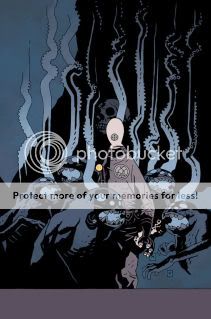
B.P.R.D.: War on Frogs #4
John Arcudi, writer
Peter Snejbjerg, artist
Dark Horse, December 2009
32 pages
$2.99
I never thought I’d see the day where I’d be happy that Dave Stewart didn’t color a Hellboyverse book. But on this New Comics Wednesday, the best colorist in the front of Previews finds himself stranded in Brown Town in the pages of Fabio Moon and Gabriel Ba’s Vertigo series debut Daytripper. And he’s left colorist Bjarne Hansen to absolutely kill it in conjunction with artist Peter Snejbjerg in this concluding issue of the gap-filling series of glorified BPRD one-shots. Generally he hews close to Stewart’s long-established palette of full blues, reds, and greens, designed to contrast against the usual washes of black (and if I’m not mistaken derived from Matt Hollingsworth’s work in the initial Hellboy miniseries). But in the issue’s spectacular climax, he adds flourescents that wouldn’t look out of place in Tron; it’s something we’ve never seen before in Mignola World, and the effect is a stunning way to suggest the Otherness of what we’re looking at. Further, Snejbjerg’s art, already a winning riff on Guy Davis’s model that smoothes out some of the rough edges in favor of a wispy vulnerability, is put through a focus-blurring filter, as if poor Johann Kraus’s view of the next world literally can’t be visually comprehended. It’s a lovely, clever, and chilling way to drive home the story by John Arcudi, which is yet another tale of one of our ostensible heroes realizing he’s in way, way over his head but continuing to struggle simply because the alternative is unbearable to contemplate. The quality control for this ever-expanding franchise during the course of this decade is one of contemporary genre comics’ minor miracles, and this issue is a happy example, and by happy I of course mean melancholy and pessimistic as Hell.
Comics Time: Multiforce
December 7, 2009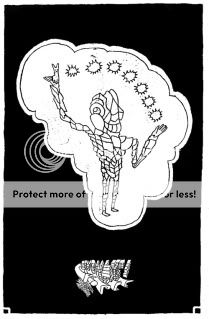
Multiforce
Mat Brinkman, writer/artist
PictureBox, 2009
22 pages
$15
We tend to think of the breakdown of civilization as a rather stark affair. Things fall apart, the center cannot hold, and before long everything’s a burnt-out husk and people in rags and/or leather underpants are scavenging the wasteland for canned peaches and guzzoline. In keeping with Fort Thunder’s general aesthetic project of information overload, Multiforce imagines the contrary: a replete Ragnarok, a jam-packed apocalypse.
A loosely linked narrative about the warring citizens of a massive mountain redoubt called Citadel City and the even stranger places above and below it, Multiforce‘s serialized strips (they originally appeared in Providence’s visual-noise bible Paper Rodeo) concern themselves primarily with bigness. A giant meets an even bigger giant, who meets an even bigger dragon; little dudes ride around inside the head of a huge dude; skeletal characters dwell in structures and even cities that are shaped like their own skulls, suggesting a preexisting being of almost unimaginable proportions. Half of the book’s narrative juice comes simply from stringing the book’s two protagonists (and the reader) along until the next massive step-up in scale can be revealed. It’s like the comics equivalent of a zoom-out, only suggested through sequential juxtaposition rather than an actual ratcheting back of the viewing plane (that actual technique is seldom if ever used here, to the best of my recollection).
The creatures, which are as gorgeous and inventive and inner-eight-year-old awesome as you’d expect from the product of a man who nowadays makes a living by creating prints of demons and shit, are a constant game of one-upsmanship as well. Brinkman lays this out in an introductory strip, in which we watch a monstrous character who’s super-proud of his awesomely dangerous bionic arm–“I HAVE THE MOST ULTRA ARM IN THE UNIVERSE”–promptly get his clock cleaned by the book’s main, inscrutable antagonist, Battlemax Ace. He’s a battle beast with an axe for one hand and a mace for the other. Yeah, it’s that kinda book. And it’s Battlemax Ace’s unstoppable rampage that brings Citadel City crashing down and provides one of the book’s few genuine narrative and logistical throughlines as he smashes his way through opponent after opponent and level after level. His awesomeness is too powerful to contain.
In many ways these beasties and their navigation of craggy subterranean spaces recalls Brinkman’s landmark collection Teratoid Heights, but that book’s wordless fervor gives way to Brinkman’s loosey-goosey verbal hijinx–his characters bumble around and talk smack like a crudely lettered cross between the Muppets and the stars of a stoner comedy. So the moments of sheer visual poetry stand out in even starker relief–our heroes flying in a sinuous, continuous curve through a Marc Bell riot of a carnival; a dropped head bouncing and rolling down a massive page-tall mountainside; the aforementioned giant skull. But the main takeaway is a set of civilizations so obliviously concerned with their own business and jaded about their potential annihilation that they’re all pretty much fiddling as Citadel City and its environs burn (and explode and implode and collapse and cave in and get smashed by Battlemax Ace and so on). Our heroes even leaven their soaring last-page getaway with a snort of “yea right.” One, two, three, what are they fightin’ for? Don’t ask ’em, they don’t give a damn.
Comics Time: Split Lip Vol. 1
December 4, 2009
Split Lip Vol. 1
Sam Costello, writer
Josh Bivens, Diego Candia, Gary Crutchley, Nelson Evergreen, Ayhan Hayrula, Brian A. Laframboise, Iain Laurie, Sami Makkonen, Brian McGleenon, Felipe Sobreiro, Kyle Strahm, artists
Tent City, 2009
158 pages
$15
Read it and buy it at SplitLipComic.com
The back cover of this collection of astute horror writer and critic Sam Costello’s anthology webcomic reads in part, “Split Lip sheds traditional horror archetypes in favor of creating dark moods, original characters, and frightening experiences.” Of the three claims I think the first is the best supported. Somber and stark in almost every particular, from plotting to dialogue to his army of collaborators’ art, Costello’s comics quietly but relentlessly reinforce the simple fact that horror is about death. There’s a funereal sadness even in the less effective pieces here, a sense that the horror Costello’s interested in stems not so much from fright as from pessimism. After all, we’re all headed for our own down endings. So to me this offsets the lack of bona fide “frightening experiences”; contra the back cover blurb, I don’t even think that’s what these comics were even going for.
That said, the individual stories vary wildly not so much in quality–I never though “man, this is junk”–as in, like I implied above, effectiveness. Costello’s admirable reliance on the visuals to tell the key parts of his stories, in particular their climaxes or climactic twists, allows the work to rise and fall on how clearly his artists can tell the story, and on a couple of occasions the answer is “not very.” I was left flummoxed by what, exactly, happened at the end of the King-esque cornfield morality play “Straw Men” and the grim fairy tale “Fitcher’s Bird,” while crucial spatial shifts in “Not Sleeping Well,” “The Consequences of a Little Alone Time,” and “School Supplies” were inadequately contextualized. Moreover, stiff figurework on “Straw,” “Consequences,” and “The Executioner Is a Lonely Men” tends toward pulp-ifying fairly restrained writing and, to return to the blurb, mitigating against the originality of the characters. (Given my predilections, I’m tempted to suggest Costello try tapping artists with an out-and-out alternative flavor to them, but I don’t wanna armchair-quarterback this thing.) And on the rare occasion where Costello opts to do the heavy lifting himself, the Ciudad Juarez meets J-horror story “Mujer,” overnarration adds a layer of remove and does in a sense of the story as a living breathing thing.
But elsewhere the writing’s sharp as a knife. Whatever the shortcomings of its visually rushed ending, “Fitcher’s Bird” is kind of uncanny in how well it captures the dark dream logic of classic fairy tales and children’s stories, with their transformations, dismemberments, and ritualistic tasks that must be performed. And the art can shine as well as obscure: Kyle Strahm’s striking white-on-black work in the Western-horror fable “Headin’ South” radiates from the page with the power of agitprop and sets up a nifty negative-image punchline panel to boot. The best of the stories here, “The Tree of Remembrance,” combines strengths on both fronts. For Costello’s part, it’s his least “scary,” most straightforwardly melancholy piece, centered on a striking visual metaphor for the way memories of those we’ve lost can both haunt and heal. Aptly named artist Nelson Evergreen makes the best impression of any of the book’s visual contributors by making the most of Costello’s (according to the book’s supplemental material) uncharacteristically loose script in terms of layout and paneling–the story appears to drift to the ground just like leaves off the titular tree. But Evergreen really kills it with a pair of heartrendingly lovely images of the story’s elderly protagonist in the full bloom of her youth–ha, as I write this I’m listening to the lilting end section to My Bloody Valentine’s “What You Want,” and it’s pretty much the visual equivalent of that. And the pair unite for a starkly gruesome final panel that adds a welcome sour note to the sad sweetness of the proceedings up until that point. It takes a lot for a collaboration of this sort to work so effectively, so when it does it’s a treat, and it’s worth tuning in again to see how often Costello and his collaborators can recapture that moment.
Comics Time: Image United #1
December 2, 2009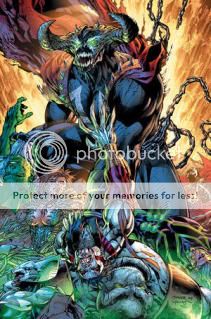
Image United #1
Robert Kirkman, writer
Erik Larsen, Rob Liefeld, Todd McFarlane, Whilce Portacio, Marc Silvestri, Jim Valentino, artists
Image, November 2009
24 pages
$3.99
Wowsers. So, uh, this is a jam comic by six of the seven Image founders, though Jim Lee makes a cameo by providing an alternate cover, which made me smile. It’s about some villains running amok and fighting various heroes for no apparent reason–that’s not my characterization of the plot, that’s the heroes’–which is a pretty fantastic encapsulation of the work of the Image founders to begin with, and certainly their work here. It’s all a moment-to-moment festival of sensation, gritted teeth and punching and blasting and charging the camera, without any kind of prologue or follow-through to place each physical action in any kind of spatial or temporal or emotional context, not even so much as a recap page to catch nostalgic readers up on characters they probably haven’t read since Nirvana was a going concern.
Entrusting layouts to Rob Liefeld (of the six they could have picked from, Liefeld!) could be said to be a mistake, in that characters like the narrator-hero Fortress or the uber-antagonist Omega Spawn burst onto the pages out of nowhere, like they teleported, even though they’re supposed to have been down the block or in the same room, but in light of the above it ends up fitting rather perfectly. At one point the big giant strong hero Badrock [sic] angrily threatens the big giant strong villain Overt-Kill [sic] over an attack we never see on a person who’s not even on panel at the time; later, the long-running Erik Larsen character Savage Dragon, whose appearance in a book filled to the brim with Silvestri and Liefeld creations feels like a walk-on by Glenn Ganges by comparison, remarks “I had no clue the girl took such a hit,” and I had to wonder if this wasn’t Kirkman having some deliberate fun. (I doubt having the arrow-based character Shaft repeat a balloon’s worth of dialogue verbatim two pages apart was deliberate, but wouldn’t it be aweome if it were?)
The most interesting thing about the project is that the artists don’t trade off sections, they draw their own characters whenever they appear, so that you can watch a Jim Valentino hero punch a Todd McFarlane villain, say. The problem with that, though, is that they’re simply not a terribly distinct collection of individual visual stylists. I mean, Larsen’s an exception of course, and Valentino doesn’t look like the rest of the gang but he doesn’t look like much of anything really, and McFarlane might stand out a little in terms of how he choreographs his characters’ physicality but there’s not much of that in this issue, so what you’re left with between Liefeld, Silvestri, Portacio, and McFarlane is a lot of squinty-eyed dudes and dudettes comprised of lots of tiny little lines, standing against generic secret base/rooftop/rubble backgrounds. There’s a manic energy to it, that’s undeniable, but it’s like an album-length guitar solo. It’s all extremely harmless and good-natured–it’s not going to upset you or offend you or leave a bad taste in your mouth, which is saying something–but it’s like being asked for your thoughts on a really rad comic drawn during study hall by the five coolest metalheads in the 9th grade, which not coincidentally is the last time I read comics by most of these guys. It’s all printed on paper stock so shiny it looks like a decade’s worth of gold-embossed chromium glow-in-the-dark holofoil covers were ground up and mixed into the pulp, like KISS’s blood or Mark Gruenwald’s ashes. I think everyone involved, from Kirkman to the Founders to the bulk of the book’s audience, got exactly what they wanted out of it.
Comics Time: High Moon Vol. 1
November 30, 2009
High Moon Vol. 1
David Gallaher, writer
Steve Ellis, artist
DC/Zuda, 2009
192 pages
$14.99
Read the strip at ZudaComics.com
Evolution in action? Here’s a case of the constraints of a comic’s production saddling it with weaknesses, only for the comic to come up with compensatory values that all but overcome them. High Moon is a Western-horror hybrid of the sort very much in vogue over the past few years–what hath Ravenous wrought?–which originally ran in DC Comics’ webcomics portal/competition site Zuda. I believe this necessitated a Sunday-strip-style landscape-format rectangular page, longer than it is tall, as well as a daily-installment delivery mechanism. The storytelling suffers for it all. There’s pretty much one plot beat per panel, with very little breathing room, and moreover nearly every panel contains terse pulp dialogue; the resulting rhythm is staccato to the point of incomprehensibility at times. It doesn’t help that writer David Gallaher’s characters are almost all types, making it even tougher to tell the players at times.
But! Sweet Jesus, look at Steve Ellis’s art. His color palette is a real revelation, fiery oranges and glacial blues all but radiating off the page even despite the book’s rough paper stock. The faces of his hardass outlaws and their lovely ladyfriends come off like a cross between fellow horror artists Terry Moore and Guy Davis, their broad-strokes emotions and intentions easy to parse amid the occasional confusion. I was particularly impressed with his creature designs, admirably ambitious and taking full advantage of Gallaher’s unique, expectation-defying brand of horror-on-the-range. I think I even detected a Robert Williams homage! Ellis’s unnecessarily lovely brushwork really shines in splashpage-style illustrative moments, where you can just sit and stare at the flowing hair and shattered glass and monstrous limbs without feeling propelled to the next rapid-fire panel. It enhances the strengths of Gallaher’s scripting–which include at least one dramatic shift in the story’s direction and an entertaining willingness to throw everything from steampunk to The Crow into the mix–and smooths over some of the weaknesses. Provided you don’t mind when action-horror tilts way way over toward the action end of things, this book is well worth checking out.
Comics Time: Chester 5000 XYV
November 27, 2009
Chester 5000 XYV
Jess Fink, writer/artist
ongoing webcomic, August 2008-November 2009 (and counting)
A steampunk porn webcomic: By god, is this the most Internet-y thing the Internet has ever produced? Regardless, it’s certainly an advertisement for the potential of the web as a publishing mechanism for comics. You can do page after page after page of a cheerful, even sentimental comic drawn in a friendly, loose-fit Craig Thompson-y style (lots of dot-eyes and pointy noses and rapturous swirls) about a woman getting fucked by a robot with a mustache, and Diamond minimums be damned. I stumbled across this by following a link trail from Kate Beaton’s place, which seems somehow appropriate–good luck getting your gag-comic series about historical figures off the ground without a David Finch variant cover, too.
To set the scene: It’s the story of a workaholic Victorian-era scientist who, unable to satisfy his lovely wife’s needs when he’s knee-deep in lab work, builds her, essentially, the world’s most sophisticated vibrator: A humanoid robot who can go-go-go-go and keep the missus busy when the Scientist’s working. Unfortunately for him but fortunately (?) for them, the lady and the robot (the titular Chester) fall in love, as best I can tell because the sex is really awesome and because of Chester’s “programming”–the scientist placed a picture of his wife where the robot’s heart would go. Eventually the Scientist attempts to sell Chester off to a local widow, but Chester has ideas of his own, and this other lovely young lady gets embroiled in the shenanigans, where we’re currently left as of the strip’s latest installment.
My relationship with this comic as I read its year-plus run in one go fluctuated fairly wildly, which surprised me. Now, steampunk’s not really my thing, and the very twee line and look Fink employs generally needs to be shored up by some genuinely meaty content to pass muster with me. Of course, this being a porno comic, there’s a pretty simple way to figure out if it’s working, and work it does. It’s graphic, so there’s that, and there’s a repeated emphasis on clitoral stimulation that all but single-handedly (rimshot!) makes up for the American education system’s sex-ed dropped ball on that score, which has left generations of young men unable to find the thing with a map and a flashlight. (Please change your standards in this regard, Department of Education–the high school girls of America will thank you!) But in addition to all the sensually drawn close-ups of genitalia, Fink has a knack for capturing not just the act, but the desire to act, if you follow me–a look in the lady’s eye as she gets ready to get it on with Chester, the heat-of-the-moment kissing and grabbing and gasping and so on. The build-up to the sequence involving the two women is particularly strong in this regard, though of course I’m a dude with a typical dude’s sensitivities in that area, so, you know, unreliable narrator.
But amid all the cute romance and hot sex and meme-able robot stuff, like I said, there’s some surprisingly tricky terrain. Is the scientist’s obsession with his work really a valid excuse for his wife to so enthusiastically and totally cuckold him–with a gift he gave her, no less? I was pretty sympathetic to the Scientist’s outrage over this–until he took it way too far and flipped my sympathies yet again. When the Widow enters the picture, as much as I enjoyed watching her dive in, I found the notion that, basically, everyone is sexually compatible with everyone…snobbish, in a way? Does that even make sense? But as the four characters are currently coupled off, I feel like we’re seeing adults make a decision about how they really want to live their lives, even though they’re making it with their sex organs at the moment rather then their brains. I don’t know…it’s heady stuff, in its way, and demanding of one’s attention and non-lizard-brain thinking, keeping you actively engaged rather than passively taking in the pretty curved lines and button-pushing romance and dirty drawings. Very interesting.
Comics Time: Just a Man #1, Lost Kisses #9-10, Worms #4, and XO #5
November 25, 2009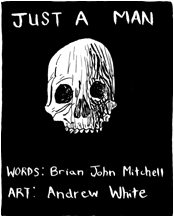
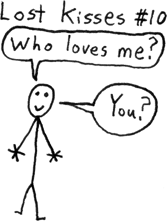 Just a Man #1, Lost Kisses #9-10, Worms #4, and XO #5
Just a Man #1, Lost Kisses #9-10, Worms #4, and XO #5
Brian John Mitchell, writer
Just a Man #1 – Andrew White, artist / 56 pages
Lost Kisses #9 & 10 – Brian John Mitchell, artist / 36 pages each
Worms #4 – Kimberlee Traub, artist / 40 pages
XO #5 – Melissa Spence Gardner, artist / 44 pages
Silber Media, 2009 (I think)
$1 each
Wow, these little suckers put the “mini” in “minicomic.” They’re just under an inch and a half square, limiting the comics they contain to one image-caption pairing per page. It’s an interesting constraint to work impose upon oneself, given that auteur Brian John Mitchell is already up against his own inability to draw. That’s not a subjective assessment, by the way–we’re not talking Jeffrey Brown lo-fi or Brian Chippendale noise or John Porcellino minimalism or Anders Nilsen stick figures or anything else that’s a matter of taste in the Mitchell-drawn Lost Kisses, we’re talking actual stick figures, with little happy-face faces and five even tinier sticks for fingers. Mitchell’s enthusiasm for making comics outstripped his ability to master even its most basic necessities. Which is kinda cute, I’ll admit, and works well enough for the kind of ramshackle navel-gazing confessional humor he’s doing in that particular series, but the air of self-indulgence is unmistakable. Making matters worse is a problem with image flow–I know, hard to believe given that you’re just dealing with one tiny picture and caption on every page. But Mitchell places the drawings on top of the captions even though the drawings respond to what’s said in the captions, so that you either have to read bottom-to-top or constantly spoil the gag for yourself. I have no idea why he does that way–surely he noticed it doesn’t scan? I don’t think it’s a formal innovation done for effect, like Chippendale’s chutes-and-ladders layouts–I just think it’s a mistake.
Which is what makes the other three comics in the envelope Mitchell sent me all the more surprising. Not due to the presence of other artists, mind you–White’s work on Just a Man is scratchily effective, particularly with some effects involving sun glare and flames, but Traub aims for abstraction and ends up coming out just sorta sloppy, while Gardner’s basic cartoony figures look like they came from any number of entry-level webcomics or student-newspaper strips. No, what’s impressive here is how the physical constraints of Mitchell’s tiny format are made to enhance his storytelling. When you have so little room that simply printing a sentence at a legible size eats up half your page, you’ve gotta keep things terse, so why not go hard-boiled and tale tales of murder and mayhem committed by flat-affect protagonists? Just a Man is a Western morality play of violent retribution; a couple of moments overstate the case, I think, but in general it’s a chilling thing, with some memorable facial expressions from White and a surprisingly, refreshingly open and un-cliche ending. XO is a series, but this is apparently the origin story for its blase hitman protagonist, and believe me you didn’t need to know this to appreciate the bracing matter-of-factness with which the character unwittingly but unhesitatingly graduates from selling drugs to eliminating an exceedingly minor threat to that undertaking. Worms is the least effective of the trio–the art just doesn’t do what it wants to do–but the story seems like an engaging enough Cold Heat-style weird-tale sci-fi mindfuck involving a young woman in peril and fighting to break free, and it sure does take a turn for the suddenly brutal at one point. In more assured hands, all three could be really killer melds of form and function. As it stands, they’re maybe not quite there, but if you wanted to spend a measly buck per book, even just to examine what they do right and what they do wrong, you’d have my blessing.
Comics Time: Remake
November 23, 2009
Remake
Lamar Abrams, writer/artist
AdHouse, May 2009
144 pages
$12.95
Buy it from AdHouse for the low low price of $5.95
Look at that cover! Oh man, striking, isn’t it? As a package–with its bold cover image and tight title font and friendly digest size and Powr Mastrs-style bendy cover and Helvetica-heavy title pages–Remake is somethin’ special. As a comic? Mmmm, I’m not quite there with it. What you’ve got here is a gentle superhero parody in the vein of Jeffrey Brown’s Bighead books–or maybe Bighead crossed with Be a Man, since author Lamar Abrams’s target here seems to be the superhero’s propensity for narcissism, destructiveness, and pique. His “hero,” the diminutive boy-robot Max Guy (he’s not named Remake, much to my surprise; hey, why is this book called Remake anyway?) is a blustery, shallow, self-absorbed asshole. He’s prone to sulking, bragging, talking shit, salting game, pigging out, playing video games, befriending his enemies and alienating his allies, breaking the fourth wall, vomiting, and so on. It sounds fun, if that’s the sort of thing you go for. And Abrams’s art helps, though I prefer the uniform line weight, rigid grid, and simplistic designs of the earlier comics collected here to the looser, more Scott Pilgrim-y work toward the back of the book; the earlier material feels like an experiment in staging dramatic, dynamic action and poses while deliberately underselling them with the tools at your disposal, like an 8-bit cover of “Bohemian Rhapsody.” But here’s the thing: It sounds like more fun than it is. Maybe I just got off on the wrong foot with the book, since its first three strips center on homophobia and animal cruelty gags (I know it’s the character, not the author, but still), but I just didn’t laugh a lot at this. There was a funny bit toward the end where Max Guy comes rocketing down from the stratosphere in the middle of a fight to smack his opponent with a pie to the face, and when he’s asked where the pie came from he said that he bought it from a guy selling them on a cloud, and then there’s a jump cut to a little guy with a mustache on a cloud with a stack of pies who says “I’m practically giving them away!”–that made me laugh. The rest, a borderline meh. It’s energetic cartooning, no doubt, and generally importing video-game influences to create something more free-form than conventional action-adventure comics plotting would allow is a good look, but for me it just didn’t cohere into a whole as winning as some of its parts.

